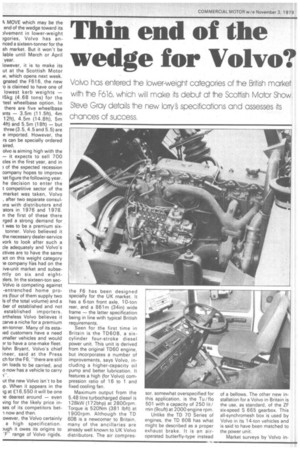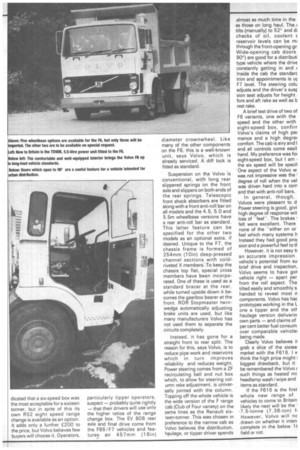Thin end of the wedge for Volvo?
Page 50

Page 51

If you've noticed an error in this article please click here to report it so we can fix it.
MOVE which may be the end of the wedge toward its )Ivement in lower-weight .gories, Volvo has annced a sixteen-tonner for the sh market. But it won't be lable until March or April year.
lowever, it is to make its ut at the Scottish Motor w, which opens next week. gnated the F616, the new
o is claimed to have one of lowest kerb weights — I5kg (4.68 tons) for the -test wheelbase option. In there are five wheelbase ints — 3.5m (11.5ft), 4m 12ft), 4.5m (14.8ft), 5m 4ft) and 5.5m (18ft) — but three (3.5, 4.5 and 5.5) are e imported. However, the rs can be specially ordered sired.
olvo is aiming high with the — it expects to sell 700 des in the first year, and in of the expected recession company hopes to improve iat figure the following year. he decision to enter the t competitive sector of the market was taken, Volvo , after two separate consul)ns with distributors and 'ators in 1976 and 1978. n the first of these there rged a strong demand for t was to be a premium sixtonner. Volvo believed it the necessary dealer-service vork to look after such a cle adequately and Volvo's ctives are to have the same ict on this weight category )e company has had on the ive-unit market and subsently on six and eightalers. In the sixteen-ton secVolvo is competing against -entrenched home pro)rs (four of them supply two Is of the total volume) and a ber of established and not established importers. artheless Volvo believes it carve a niche for a premium en-tonner. Many of its esteied customers have a need ;mailer vehicles and would 3r to have a one-make fleet.
lohn Bryant, Volvo's chief ineer, said at the Press ch for the F6, "there are still on loads to be carried, and o now has a vehicle to carry
ut the new Volvo isn't to be ip. When it appears in the 1g at £16,550 it will be one le dearest around — even ving for the likely price inses of its competitors bet-I now and then.
owever, the Volvo certainly a high specification. nigh it owes its origins to 'F" range of Volvo rigids, the F6 has been designed specially for the UK market. It has a 6-ton front axle, 10-ton rear, and a 861m (34in) wide frame — the latter specification being in line with typical British requirements.
Seen for the first time in Britain is the TD60B, a sixcylinder four-stroke diesel power unit. This unit is derived from the original TD60 engine, but incorporates a number of improvements, says Volvo, including a higher-capacity oil pump and better lubrication. It features a high (for Volvo) compression ratio of 16 to 1 and fixed cooling fan.
Maximum output from the 5.48 litre turbocharged diesel is 128kW (172bhp) at 2800rpm. Torque is 520Nm (381 lbft) at 1900rpm. Although the TD 60B is a newcomer to Britain, many of the ancillaries are already well known to UK Volvo distributors. The air compres sor, somewhat overspecified for this application, is the Tu /flo 501 with a capacity of 250 lit/ min (9cuft) at 2000 engine rpm.
Unlike the TD 70 Series of engines, the TD 60B has what might be described as a proper exhaust brake. It is an airoperated butterfly-type instead of a bellows. The other new installation for a Volvo in Britain is the use, as standard, of the ZF six-speed S 665 gearbox. This all-synchromesh box is used by Volvo in its 14-ton vehicles and is said to have been matched to the power unit.
Market surveys by Volvo in dicated that a six-speed box was the most acceptable for a sixteen tonner, but in spite of this its own R52 eight speed range change is available as an option. It adds only a further £200 to the price, but Volvo believes few buyers will choose it. Operators, particularly tipper operators, suspect — probably quite rightly — that their drivers will use only the higher ratios of the range change box. The EV 80B rear axle and final drive come from the F86/ F7 vehicles and features an 457mm (18in) diameter crownwheel. Like many of the other components on the F6, this is a well-known unit, says Volvo, which is already serviced. A diff lock is fitted as standard.
Suspension on the Volvo is conventional, with long rear slippered springs on the front axle and slippers on both ends of the rear springs. Telescopic front shock absorbers are fitted along with a front anti-roll bar on all models and the 4.5, 5.0 and 5.5m wheelbase versions have a rear anti-roll bar as standard. This latter feature can be specified for the other two models as an optional extra, if desired. Unique to the F7, the chassis frame is formed of 254mm (10in) deep-pressed channel sections with coldriveted X members. To keep the chassis top flat, special cross members have been incorporated. One of these is used as a standard bracer at the rear, while turned upside down it becomes the gearbox bearer at the front. ROR Stopmaster twinwedge automatically adjusting brake units are used, but like many manufacturers Volvo has not used them to separate the circuits completely.
Instead, it has gone for a straight front to rear split. The reason for this, says Volvo, is to reduce pipe work and reservoirs which in turn improves reliability and reduces weight. Power steering comes from a ZF recirculating ball and nut box which, to allow for steering column rake adjustment, is universally jointed with the column. Topping off the whole vehicle is the wide version of the F range cab (Club of Four variety) on the same lines as the Renault sixteen-tonner. This was chosen in preference to the narrow cab as Volvo believes the distribution, haulage, or tipper driver spends
almost as much time in the as those on long haul. The tilts (manually) to 52° and d; checks of oil, coolant C reservoir levels can be m! through the front-opening gr Wide-opening cab doors 901 are good for a distributi type vehicle where the drive constantly getting in and ( Inside the cab the standarc trim and appointments is Llf F7 level. The steering colu adjusts and the driver's susr sion seat adjusts for height fore and aft rake as well as b rest rake.
A brief test drive of two of F6 variants, one with the speed and the other with eight-speed box, confirr Volvo's claims of high pei mance and a high clegrei comfort. The cab is airy and I and all controls come easil hand. My preference was foi eight-speed box, but I am : the six speed will be specii 'One aspect of the Volvo w was not impressive was the degree of roll when the vet was driven hard into a corn and that with anti-roll bars.
In general, though, Volvos were pleasant to d Power steering is good, givi high degree of response wit loss of "feel". The brakes I felt were excellent. There none of the "either on or feel which many systems h Instead they had good proc sion and a powerful feel to tt
However, it is not easy t( an accurate impression vehicle's potential from su brief drive and inspection, Volvo seems to have got vehicle right — apart per from the roll aspect. The tilted easily and smoothly s handed to reveal most n components. Volvo has hac prototypes working in the L one a tipper and the otthaulage version deliverin own parts — and claims of per cent better fuel consum over comparable vehicle! being made.
Clearly Volvo believes it grab a slice of the sixtee market with the F616. I v think the high price might I biggest drawback, but it be remembered the Volvo ( such things as heated' mi. headlamp wash/wipe and items as standard.
If the F616 is the first whole new range of vehicles to come to Britain likely the next will be the .7.5-tonne (7.38-ton) -I, However, Volvo will nc drawn on whether it inten complete in the below 11 field or not.




























































































































